Tuesday, 12 June, Markets and Tintoretto at the Luxembourg
Written 14 June 2018
We're definitely falling into a pattern similar to our routine at home. I get up and have breakfast (except that here, I get to go out to a bakery and bring back a lovely bread and pastries) while David sleeps in. Then I write or go out and explore the neighborhood. David gets up in time for lunch, either near here or near our activity for the day (chosen the night before) and head out to do something touristy. Then we come back here in time to rest our feet, change our clothes and go out for dinner. If lunch is heavy, we try for a light supper, and vice versa.
On Tuesday, I had leftover bread and was anxious to get out and explore those markets, so I reheated the remaining chunk of baguette and got out one of my little flat round goat cheeses, a chunk of the sheep's milk cheese I got for David, and some butter and jam and had a very satisfactory breakfast off that.
Written 15 June 2018
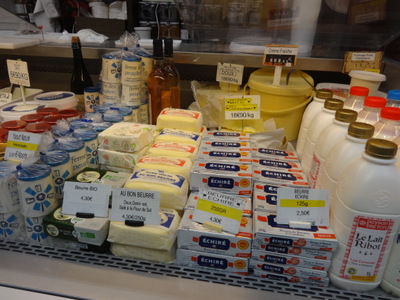
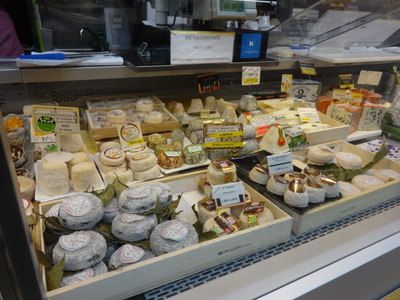 The Marché des Enfants Rouges (named for the inhabitants of a local orphanage, now gone, who always wore red) was not what I expected. I knew it didn't have a butcher, but there's one just a couple of doors down the street. It has a vegetable seller, a cheese merchant, and a fishmonger (who hadn't even set up his display yet when I was there about 9 a.m.), but it's not really about raw materials. Almost all the space is devoted to purveyers of prepared food for takeout or to eat in place.
The Marché des Enfants Rouges (named for the inhabitants of a local orphanage, now gone, who always wore red) was not what I expected. I knew it didn't have a butcher, but there's one just a couple of doors down the street. It has a vegetable seller, a cheese merchant, and a fishmonger (who hadn't even set up his display yet when I was there about 9 a.m.), but it's not really about raw materials. Almost all the space is devoted to purveyers of prepared food for takeout or to eat in place.
The photos here are of the cheese merchant's display. At the left are the many kinds of butter available, some in neatly wrapped bricks, some in "mottes" or loaves, huge cylinders from which the merchant cuts off the amount you want. At the back, near the end of the row of milk jugs, is a big yellow bucket full of "crème fraiche," very popular in France. It's not "fresh cream," as you might think, but a thickened half-soured version. Yummy. To the left of the bucket is the remaining bottom third of a motte of butter, and to the left of the butter are rows of yogurts.
Then the cheeses begin. The shot at the right shows mainly small, soft cheese, most of them goat. Some have a white rind, some an ashed (gray) rind (like the Parthenays in the front left and the cylindrical logs of St. Maur behind the largest label. Near the middle are some fresh cheese rolled in herbs or pepper flakes, and at the back right are a couple of Rouqeforts. At the extreme left are a couple of of fresh cheeses covered with macerated raisins and bits of dried apricots.
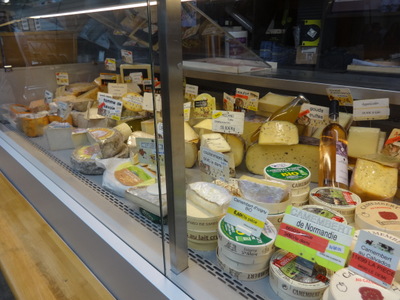
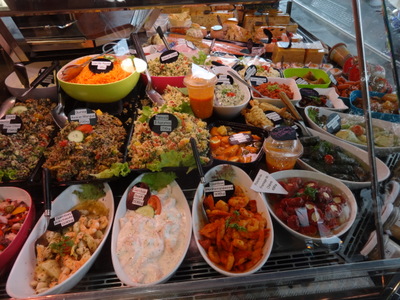 Farther to the left, the shade from soft, floury-rinded disks like Camembert and Brie, to the firmer, bacterially (as opposed to fungally) ripened wash-rinds, like the various Swisses and Gruyeres, Beaufort, Cantal, Comté, etc. Makes me hungry.
Farther to the left, the shade from soft, floury-rinded disks like Camembert and Brie, to the firmer, bacterially (as opposed to fungally) ripened wash-rinds, like the various Swisses and Gruyeres, Beaufort, Cantal, Comté, etc. Makes me hungry.
At the right is a shot of part of the display of a cold-food "traiteur" (usually translated "caterer," but maybe more like "deli salad monger"). Note the wide variety and appetizing presentation. Three kinds of marinated shrimp salad, five kinds of tabouleh, stuffed grape leaves, little stuffed peppers, tempura shrimp, artichokes, and more. The tall covered plastic cups are gazpacho.
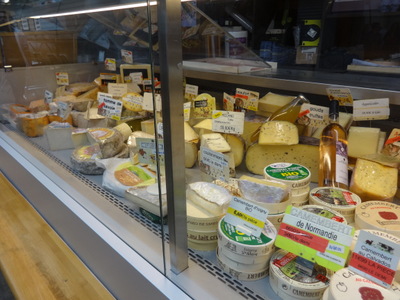
 His other case had crayfish salad, marinades of beets, mushrooms, avocado, beans, corn, and various mixtures.
His other case had crayfish salad, marinades of beets, mushrooms, avocado, beans, corn, and various mixtures.
Finally, here's part of his assortment of cold terrines, patés, and smoked fish. The terrines are coated with aspic and include, chicken with veggies, crayfish, salmon and horseradish, salmon and sorrel, skate and citrus, pork and pistachios, and little individual domes each containing a hard boiled egg wrapped in smoked salmon and embedded in aspic. At the left, you can see puff-pastry cylinders and patty shells filled with creamed stuff, ready to reheat in the oven. Just think of the amount of slicing and dicing that goes on in this guy's prep kitchen!
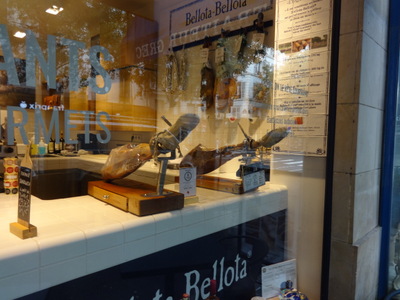
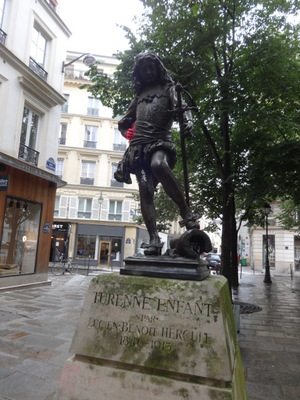 The window of a nearby shop, not yet open for the day, displayed these two whole hams, of different provenances and prices, clamped into frames for convenience of carving. The intact hoof of each one, protruding toward the spectator, is discreetly covered by a little cloth bag.
The window of a nearby shop, not yet open for the day, displayed these two whole hams, of different provenances and prices, clamped into frames for convenience of carving. The intact hoof of each one, protruding toward the spectator, is discreetly covered by a little cloth bag.
My conclusion was that Enfants Rouges doesn't really get underway until lunchtime, when droves of people probably show up to buy take-out food, so I decided to go check out the Tuesday-and-Saturday open Marché Popincourt. On the way, I walked past this bronze statue of Turenne as a child. Turenne (Henri de La Tour d'Auvergne, vicomte de Turenne, 1611–1675) was a famous military man and eventually Marshal of France for whom a major local street is named, explaining the presence of the statue here. I have no idea why somebody spray-painted his right hand pink. A few days later, someone (else?) had hastily white-washed that same hand, leaving some patches of pink and splatters of white all down his right coat-tail.
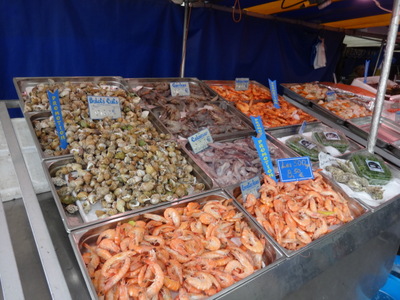
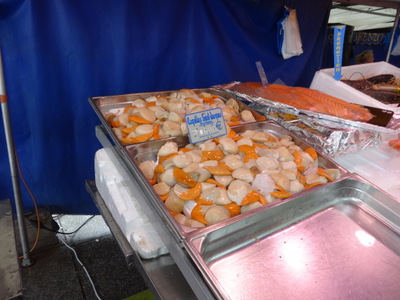 The Popincourt market is definitely all about raw materials. It occupies the broad median of the Boulevard Richard Lenoir and therefore the "roof" of the underground Canal St. Martin. The space is wide enough to accommodate two aisles with stalls on both sides, and it extends over several blocks. A few stalls near the ends sold clothing or prepared food like marinated salads huge assortments of different olives, but most of it consisted of vast arrays of fresh fruits and vegetables, butchers' stalls, sellers of cheese and butter, and three different fishmongers.
The Popincourt market is definitely all about raw materials. It occupies the broad median of the Boulevard Richard Lenoir and therefore the "roof" of the underground Canal St. Martin. The space is wide enough to accommodate two aisles with stalls on both sides, and it extends over several blocks. A few stalls near the ends sold clothing or prepared food like marinated salads huge assortments of different olives, but most of it consisted of vast arrays of fresh fruits and vegetables, butchers' stalls, sellers of cheese and butter, and three different fishmongers.
The fruits and vegetables included nothing terribly exotic or unexpected, but the quality was vibrant. I was tempted by the large purple figs, and I also saw big baskets of fresh almonds, still covered by their fuzzy fruit. As always, though, I was drawn to the displays of fish and seafood, which always are exotic and exciting. The photo at the left includes a big bin (at the upper left) of "bulots" small cooked whelks, eaten cold with mayo. Then four kinds of shrimp (some called shrimp and some "gambas," which seems to mean large shrimp; "prawns" maybe?), a bin of small raw squid, and at the lower right a few oysters and plastic clamshell boxes of Salicornia europaea (samphire, a salt-loving seaside flowering plant in the Amaranthaceae that's a popular garnish for seafood).
The photo at the right shows big bins of shucked, ready-to-cook scallops, each accompanied by its bright orange roe, which for some reason, American markets don't sell and Americans don't eat.
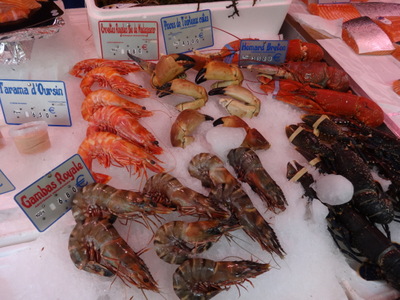
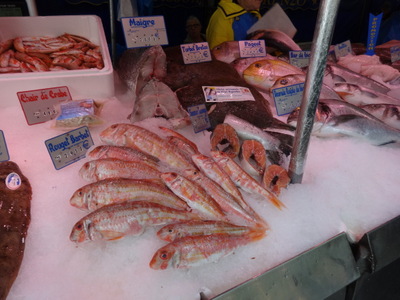 Right next to them was this field of ice displaying a small plastic tub of "tarama d'oursin" (urchin-roe spread) and some crab claws that look a lot like American stone crab but are actually claws of Cancer pagurus. The truly amazing things in this photo, though, are the two kinds of "gambas royales" (farmed red Penaeus monodon from Madagascar and gray "Aristeidae penaeoidea," source unspecified). Note their size in comparison to the pound or pound-and-a-quarter live and cooked lobsters down the right side of the photo!
Right next to them was this field of ice displaying a small plastic tub of "tarama d'oursin" (urchin-roe spread) and some crab claws that look a lot like American stone crab but are actually claws of Cancer pagurus. The truly amazing things in this photo, though, are the two kinds of "gambas royales" (farmed red Penaeus monodon from Madagascar and gray "Aristeidae penaeoidea," source unspecified). Note their size in comparison to the pound or pound-and-a-quarter live and cooked lobsters down the right side of the photo!
The photo on the right starts with the edge of a flatfish at the extreme left, then a fan of rouget barbet (Mullus barbatus), considered the best kind of rouget. When people say that mullet is considered a delicacy in Europe and has been cultivated since the time of the ancient Egyptians, this is the fish they mean, not our gray mullet of north Florida. The white bin at the top left is the same thing, but smaller ones. In front of that is a plastic pouch of crabmeat. Next to the right are maigre (Argyrosomus regius, meager) and wild-caught salmon (salmo salar), both cut into steaks. Then a whole Breton turbot (Psetta maxima). The next row is pageot (Pagellus erythrinus, common pandora) in the back and line-caught daurade royale (Sparus aurata, gilt-head seabream) in the front. Then a whole row of line-caught bar (Dicentrarchus labrax, European seabass) and finally a heat of filets of lotte (Lophius piscatorius, monkfish), which is indicated by a tall blue arrow reading "Promotion" because it's on sale. I love the practice of French fishmongers of including the scientic name of the fish on the label—makes it so much easier to look up what is really is and what it might be called in English.
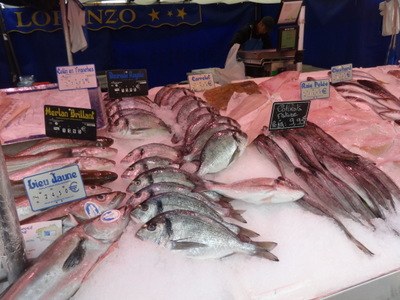
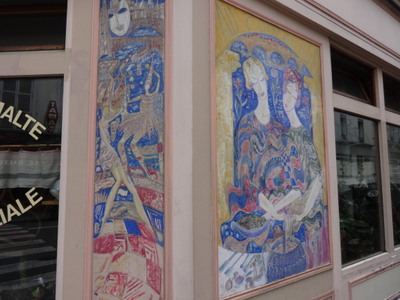 And the display goes on! Left to right, we have (in back) slices of colin (Merluccius merluccius, hake) in the middle merlan brillant (Merlangius merlangus, whiting), and in front lieu jaune (Pollachius pollachius, Atlantic pollock). These are Atlantic species, people! Why don't we get them in our fish markets?!
And the display goes on! Left to right, we have (in back) slices of colin (Merluccius merluccius, hake) in the middle merlan brillant (Merlangius merlangus, whiting), and in front lieu jaune (Pollachius pollachius, Atlantic pollock). These are Atlantic species, people! Why don't we get them in our fish markets?!
Next a double column of more daurade royale, then (in back) a whole carrelet (Pleuronectes platessa, plaice) and some unmarked filets, probably also carrelet, and in front baby hakes for frying whole. Next a whole heap of peeled skate (Raja clavata) wings, and finally some chinchard (Trachurus sp., horse mackerel). I sure wish our markets had this kind of variety and more fish available whole.
The photo at the right here is just the corner of a Maltese restaurant that caught my eye. I don't know whether the painting is Maltese or just left over from a previous tenant.
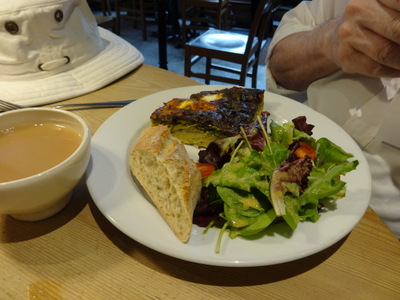
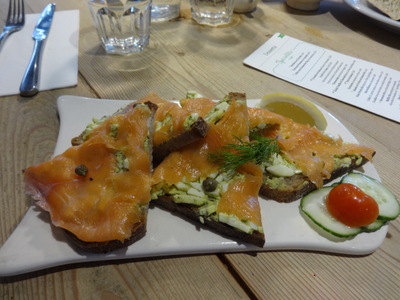 To our surprise, we have a Pain Qotidien in the neighborhood, so we decided to add another branch to our collection—we've eaten at a couple in Belgium, at least one in Washington, and maybe even one elsewhere in France. Anyway, David ordered the "baked omelet" of spinach and other veggies (sort of a crustless quiche), which came with salad and a chunk of bread, and I had the tartine mimosa—bread spread with egg salad green with dill and covered with smoked salmon and a few capers. Garnish of a lemon wedge half a cherry tomato and a few slices of cucumber.
To our surprise, we have a Pain Qotidien in the neighborhood, so we decided to add another branch to our collection—we've eaten at a couple in Belgium, at least one in Washington, and maybe even one elsewhere in France. Anyway, David ordered the "baked omelet" of spinach and other veggies (sort of a crustless quiche), which came with salad and a chunk of bread, and I had the tartine mimosa—bread spread with egg salad green with dill and covered with smoked salmon and a few capers. Garnish of a lemon wedge half a cherry tomato and a few slices of cucumber.
I liked the tartine very much, but David found the "omelet" very bland and vastly undersalted. To make things worse, the salt in the grinder on the table had caked, and he couldn't get it to dispense enough salt to help.
For dessert, we split a chocolate "torsadé," two narrow strips of croissant dough sandwiching pastry cream and chocolate chips and twisted double-helix fashion before baking.
Written 16 June 2018
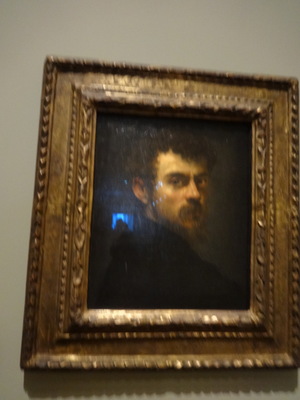
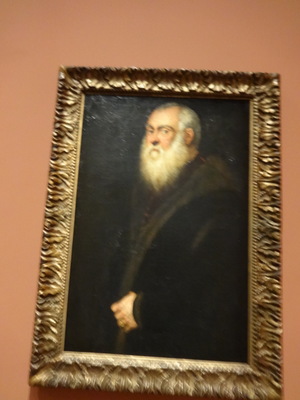 Then we caught the #96 bus to the Luxembourg Museum (in the gardens of the same name) for "Tintoretto, Birth of a Genius," a special exhibition on a particular period in the young Tintoretto's life when his individual artistic voice emerged.
Then we caught the #96 bus to the Luxembourg Museum (in the gardens of the same name) for "Tintoretto, Birth of a Genius," a special exhibition on a particular period in the young Tintoretto's life when his individual artistic voice emerged.
It started right out with this striking self-portrait and later followed up with the impressive portrait at the right. The subject is unidentified but is conjectured to be the artist's father. The father was a dyer by trade, hence the name by which the artist came to be known. His real name was something else.
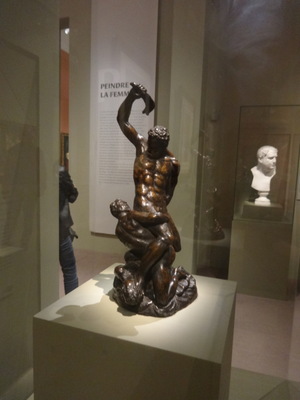
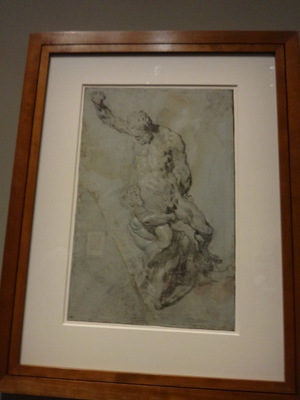 To illustrate how Tintoretto studied the work of other artists, particularly sculptors, the organizers included this small bronze of Samson subduing two Philistines (thought to be by Daniele da Volterra, after Michaelangelo) together with Tintoretto's sketch of it.
To illustrate how Tintoretto studied the work of other artists, particularly sculptors, the organizers included this small bronze of Samson subduing two Philistines (thought to be by Daniele da Volterra, after Michaelangelo) together with Tintoretto's sketch of it.
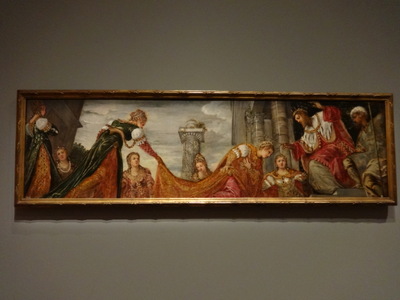
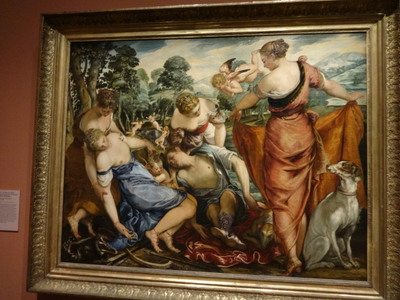 Here, at the left, he protrays Esther before Assuërus—not a bible story I'm familiar with, but it makes for a very decorative painting.
Here, at the left, he protrays Esther before Assuërus—not a bible story I'm familiar with, but it makes for a very decorative painting.
At the right is the death of Adonis, killed during a boar hunt. No one came out well here. The boar (visible in the background) and Adonis both died, and Venus (showed here fainting in a blue dress) was devastated. Not a good day.
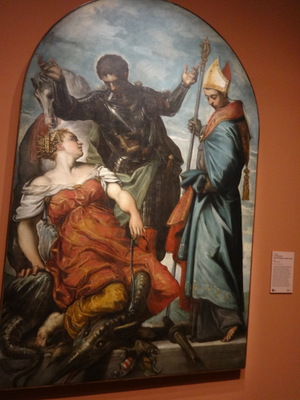
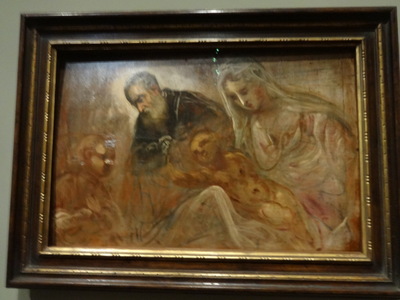 At the left here are a princess, St. George (in the middle), and St. Louis. The lady is sitting on the slain dragon, which looks like something out of Escher.
At the left here are a princess, St. George (in the middle), and St. Louis. The lady is sitting on the slain dragon, which looks like something out of Escher.
At the right is the piece I found more impressive (and informative) than anything else in the exhibition. At first glance, it looks like an unfinished painting, and at second, like a sketch or study for a painting, but as the audioguide pointed out, it's probably a proposal for a painting, intended to show a client considering a commission what the artist had in mind for his protrayal of the holy family and the young John the Baptist. First, it's painted on a piece of scrap wood, full of chips and dings (not what you'd use for a painting you intended to finish); second, it's done in oils rather than the pencil or charcoal usually used for preparatory sketches (probably because the forms could be given a more rounded, three-dimensional look); and third, the head of Joseph is finished in exquisite detail (to show the client what the painter could really do with the finished work). If I could pick one to hang on my wall, this would be it. Second choice, the self-protrait (I had to make do with buying a bookmark showing the latter).
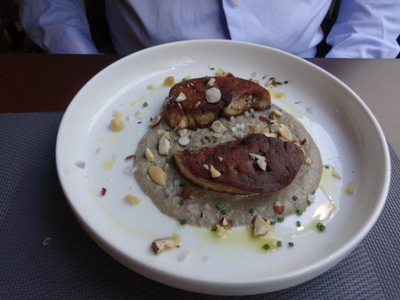
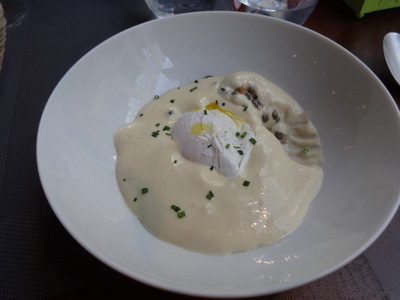 When our feet gave out, we caught the #96 bus back home to rest up before dinner.
When our feet gave out, we caught the #96 bus back home to rest up before dinner.
Looking through the Gault-Millau guide, David came across a restaurant called "Nous 4" (We 4), a tiny hole in the wall out in the 12th arrondissement. It has the classic bistro storefront—windows set in wooden frames—but is set into the side of an otherwise modern multistory building. The award-winning young chef is supported in his endeavor by his wife and two young children (hence the name), and he really knows what he's doing.
David started with the sautéed foie gras on a bed of mushroom purée sprinkled with hazelnuts, peanuts, and chives. Yummy.
I had the poached egg with lentils and mustard sauce, which turned out to be a poached egg set in the middle of a perfect cloud of fluffy, creamy, mild mustard cream, which entirely covered the lentils stewed with carrots and onions. Before the photo, I dug into the sauce a little to reveal a few of the lentils. Extremely yummy!
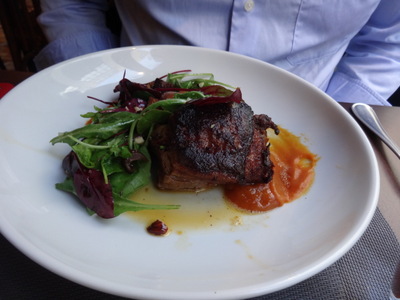
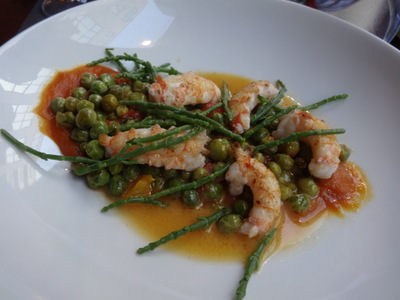 David's main course was a boneless chunk of pork ribs, braised and then glazed under the broiler, served with salad and sweet-potato purée.
David's main course was a boneless chunk of pork ribs, braised and then glazed under the broiler, served with salad and sweet-potato purée.
Mine was langoustine (Nephrops norvegicus) tails and braised English peas on sweet potato purée liberally strewn with samphire, which is juicy, crispy, and salty.
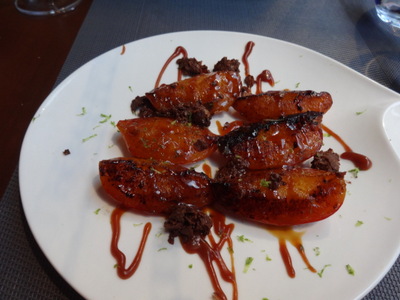
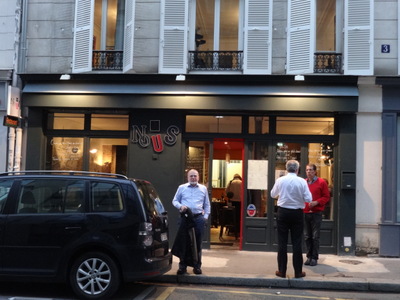 For dessert, we both chose the caramelized grilled apricots with crispy chocolate bits. I would have eaten the whole thing with a fork, using it to cut the apricot wedges and at the end to scrape up the stray caramel sauce, but for some reason the French always insist of having you eat dessert with a soup spoon, so some of the sauce went unscraped.
For dessert, we both chose the caramelized grilled apricots with crispy chocolate bits. I would have eaten the whole thing with a fork, using it to cut the apricot wedges and at the end to scrape up the stray caramel sauce, but for some reason the French always insist of having you eat dessert with a soup spoon, so some of the sauce went unscraped.
Finally, here's David out front as wel left, in front of the whimsical sign and next to two guys who interrupted their meal to go outside for a smoke.
Previous entry
List of Entries
Next entry

 The Marché des Enfants Rouges (named for the inhabitants of a local orphanage, now gone, who always wore red) was not what I expected. I knew it didn't have a butcher, but there's one just a couple of doors down the street. It has a vegetable seller, a cheese merchant, and a fishmonger (who hadn't even set up his display yet when I was there about 9 a.m.), but it's not really about raw materials. Almost all the space is devoted to purveyers of prepared food for takeout or to eat in place.
The Marché des Enfants Rouges (named for the inhabitants of a local orphanage, now gone, who always wore red) was not what I expected. I knew it didn't have a butcher, but there's one just a couple of doors down the street. It has a vegetable seller, a cheese merchant, and a fishmonger (who hadn't even set up his display yet when I was there about 9 a.m.), but it's not really about raw materials. Almost all the space is devoted to purveyers of prepared food for takeout or to eat in place. 
 Farther to the left, the shade from soft, floury-rinded disks like Camembert and Brie, to the firmer, bacterially (as opposed to fungally) ripened wash-rinds, like the various Swisses and Gruyeres, Beaufort, Cantal, Comté, etc. Makes me hungry.
Farther to the left, the shade from soft, floury-rinded disks like Camembert and Brie, to the firmer, bacterially (as opposed to fungally) ripened wash-rinds, like the various Swisses and Gruyeres, Beaufort, Cantal, Comté, etc. Makes me hungry.
 His other case had crayfish salad, marinades of beets, mushrooms, avocado, beans, corn, and various mixtures.
His other case had crayfish salad, marinades of beets, mushrooms, avocado, beans, corn, and various mixtures.
 The window of a nearby shop, not yet open for the day, displayed these two whole hams, of different provenances and prices, clamped into frames for convenience of carving. The intact hoof of each one, protruding toward the spectator, is discreetly covered by a little cloth bag.
The window of a nearby shop, not yet open for the day, displayed these two whole hams, of different provenances and prices, clamped into frames for convenience of carving. The intact hoof of each one, protruding toward the spectator, is discreetly covered by a little cloth bag.
 The Popincourt market is definitely all about raw materials. It occupies the broad median of the Boulevard Richard Lenoir and therefore the "roof" of the underground Canal St. Martin. The space is wide enough to accommodate two aisles with stalls on both sides, and it extends over several blocks. A few stalls near the ends sold clothing or prepared food like marinated salads huge assortments of different olives, but most of it consisted of vast arrays of fresh fruits and vegetables, butchers' stalls, sellers of cheese and butter, and three different fishmongers.
The Popincourt market is definitely all about raw materials. It occupies the broad median of the Boulevard Richard Lenoir and therefore the "roof" of the underground Canal St. Martin. The space is wide enough to accommodate two aisles with stalls on both sides, and it extends over several blocks. A few stalls near the ends sold clothing or prepared food like marinated salads huge assortments of different olives, but most of it consisted of vast arrays of fresh fruits and vegetables, butchers' stalls, sellers of cheese and butter, and three different fishmongers.
 Right next to them was this field of ice displaying a small plastic tub of "tarama d'oursin" (urchin-roe spread) and some crab claws that look a lot like American stone crab but are actually claws of Cancer pagurus. The truly amazing things in this photo, though, are the two kinds of "gambas royales" (farmed red Penaeus monodon from Madagascar and gray "Aristeidae penaeoidea," source unspecified). Note their size in comparison to the pound or pound-and-a-quarter live and cooked lobsters down the right side of the photo!
Right next to them was this field of ice displaying a small plastic tub of "tarama d'oursin" (urchin-roe spread) and some crab claws that look a lot like American stone crab but are actually claws of Cancer pagurus. The truly amazing things in this photo, though, are the two kinds of "gambas royales" (farmed red Penaeus monodon from Madagascar and gray "Aristeidae penaeoidea," source unspecified). Note their size in comparison to the pound or pound-and-a-quarter live and cooked lobsters down the right side of the photo! 
 And the display goes on! Left to right, we have (in back) slices of colin (Merluccius merluccius, hake) in the middle merlan brillant (Merlangius merlangus, whiting), and in front lieu jaune (Pollachius pollachius, Atlantic pollock). These are Atlantic species, people! Why don't we get them in our fish markets?!
And the display goes on! Left to right, we have (in back) slices of colin (Merluccius merluccius, hake) in the middle merlan brillant (Merlangius merlangus, whiting), and in front lieu jaune (Pollachius pollachius, Atlantic pollock). These are Atlantic species, people! Why don't we get them in our fish markets?! 
 To our surprise, we have a Pain Qotidien in the neighborhood, so we decided to add another branch to our collection—we've eaten at a couple in Belgium, at least one in Washington, and maybe even one elsewhere in France. Anyway, David ordered the "baked omelet" of spinach and other veggies (sort of a crustless quiche), which came with salad and a chunk of bread, and I had the tartine mimosa—bread spread with egg salad green with dill and covered with smoked salmon and a few capers. Garnish of a lemon wedge half a cherry tomato and a few slices of cucumber.
To our surprise, we have a Pain Qotidien in the neighborhood, so we decided to add another branch to our collection—we've eaten at a couple in Belgium, at least one in Washington, and maybe even one elsewhere in France. Anyway, David ordered the "baked omelet" of spinach and other veggies (sort of a crustless quiche), which came with salad and a chunk of bread, and I had the tartine mimosa—bread spread with egg salad green with dill and covered with smoked salmon and a few capers. Garnish of a lemon wedge half a cherry tomato and a few slices of cucumber.
 Then we caught the #96 bus to the Luxembourg Museum (in the gardens of the same name) for "Tintoretto, Birth of a Genius," a special exhibition on a particular period in the young Tintoretto's life when his individual artistic voice emerged.
Then we caught the #96 bus to the Luxembourg Museum (in the gardens of the same name) for "Tintoretto, Birth of a Genius," a special exhibition on a particular period in the young Tintoretto's life when his individual artistic voice emerged.
 To illustrate how Tintoretto studied the work of other artists, particularly sculptors, the organizers included this small bronze of Samson subduing two Philistines (thought to be by Daniele da Volterra, after Michaelangelo) together with Tintoretto's sketch of it.
To illustrate how Tintoretto studied the work of other artists, particularly sculptors, the organizers included this small bronze of Samson subduing two Philistines (thought to be by Daniele da Volterra, after Michaelangelo) together with Tintoretto's sketch of it.
 Here, at the left, he protrays Esther before Assuërus—not a bible story I'm familiar with, but it makes for a very decorative painting.
Here, at the left, he protrays Esther before Assuërus—not a bible story I'm familiar with, but it makes for a very decorative painting.
 At the left here are a princess, St. George (in the middle), and St. Louis. The lady is sitting on the slain dragon, which looks like something out of Escher.
At the left here are a princess, St. George (in the middle), and St. Louis. The lady is sitting on the slain dragon, which looks like something out of Escher.
 When our feet gave out, we caught the #96 bus back home to rest up before dinner.
When our feet gave out, we caught the #96 bus back home to rest up before dinner. 
 David's main course was a boneless chunk of pork ribs, braised and then glazed under the broiler, served with salad and sweet-potato purée.
David's main course was a boneless chunk of pork ribs, braised and then glazed under the broiler, served with salad and sweet-potato purée.
 For dessert, we both chose the caramelized grilled apricots with crispy chocolate bits. I would have eaten the whole thing with a fork, using it to cut the apricot wedges and at the end to scrape up the stray caramel sauce, but for some reason the French always insist of having you eat dessert with a soup spoon, so some of the sauce went unscraped.
For dessert, we both chose the caramelized grilled apricots with crispy chocolate bits. I would have eaten the whole thing with a fork, using it to cut the apricot wedges and at the end to scrape up the stray caramel sauce, but for some reason the French always insist of having you eat dessert with a soup spoon, so some of the sauce went unscraped.